AP Calculus
Calculus_SF_Theorem
Calculus_SF_Theorem
Create successful ePaper yourself
Turn your PDF publications into a flip-book with our unique Google optimized e-Paper software.
Special Focus: The Fundamental<br />
Theorem of <strong>Calculus</strong><br />
2002 AB2/BC2<br />
The rate at which people enter an amusement park on a given day is modeled by the<br />
function E defined by<br />
E t<br />
( ) =<br />
15600<br />
.<br />
2<br />
( t − 24t<br />
+ 160)<br />
The rate at which people leave the same amusement park on the same day is modeled by<br />
the function L defined by<br />
( ) =<br />
L t<br />
9890<br />
.<br />
2<br />
( t − 38t<br />
+ 370)<br />
Both E(t) and L(t) are measured in people per hour, and time t is measured in hours<br />
after midnight. These functions are valid for 9 ≤ t ≤ 23, the hours during which the park<br />
is open. At time t = 9 there are no people in the park.<br />
(a) How many people have entered the park by 5:00 P.M. (t = 17)? Round answer<br />
to the nearest whole number.<br />
t<br />
( ) = −<br />
( )<br />
(c) Let H t ∫ E( x) L( x)<br />
dx for 9 ≤ t ≤ 23. The value of H(17) to the<br />
9<br />
nearest whole number is 3725. Find the value of H' (17) and explain the<br />
meaning of H(17) and H' (17) in the context of the park.<br />
This is again a Fundamental Theorem of <strong>Calculus</strong> question. How can we tell? We are<br />
given information about rates of change (rate at which people enter a park and rate at<br />
which people leave the park), and we are asked about the change in the number of people<br />
in the park. Notice the units of E(t) and L(t) are people per hour. Thus the definite<br />
integral of E(t) will give the change in the number of people who enter the park, so in<br />
17<br />
part (a) we need to evaluate ∫ E ( t ) dt numerically with the calculator. We again need<br />
9<br />
to use the FTC in part (c) to explain the meaning of H(17) and to compute H' (17). The<br />
second version of the FTC tells us immediately that<br />
d t<br />
H′ ( t) = ∫ ( E( x) − L( x)) dx = E( t) − L( t)<br />
,<br />
dt 9<br />
and so H′ ( 17) = E( 17) − L( 17 ). Moreover, once we recognize that E(t) – L(t) represents<br />
the rate of change of the number of people in the park, the FTC also allows us to<br />
conclude that H(t) is the total change in the number of people in the park between<br />
78<br />
<strong>AP</strong>® <strong>Calculus</strong>: 2006–2007 Workshop Materials


